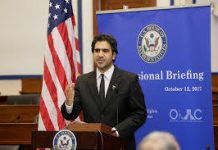Might ISIS bring a resolution in Syria?
Michael Young| The Daily Star
12/09/14
At the time this was written, it was expected that President Barack Obama, in explaining to Americans his military strategy against ISIS, would announce that he intended to extend airstrikes into Syria.
That may be true, but it leads us to other questions. What is the future of Bashar Assad’s regime? Would such attacks help his forces, or on the contrary might foreign warplanes over Syrian territory somehow precipitate his departure? Most important, how will the implicit alliance in Iraq between the United States and Iran fare in Syria, where, clearly, the two countries have different interests despite their shared hostility toward ISIS?
Assad’s ability to survive a three-and-a-half-year uprising has been largely due to the assistance of Iran and Russia, which have supplied his forces with weapons, manpower and intelligence, as well as helping devise a military strategy on the ground. Yet none of this has been enough to turn the tide in Syria. The war has become a black hole for Iran and its Lebanese Hezbollah ally, while Russia is preoccupied elsewhere, with the Ukraine crisis pitting it against NATO and the West.
As Assad watches developments around him, he cannot be reassured. His reliance on minorities, including his Alawite coreligionists, to stay in power will fail. Alawites, Christians and Shiites cannot indefinitely guarantee Assad’s political survival, with the communities already taking very heavy losses.
As for the regime’s outside backers, the future looks uncertain. Iran has already paid billions of dollars to prop up Assad rule, money it desperately needs elsewhere, and recently it lost a vital land connection with Syria when ISIS took over western Iraq. That explains the Iranians’ willingness to tolerate American military action in Iraq, and, one would assume, in Syria’s ISIS-controlled eastern and northeastern provinces as well.
Closer to Damascus the picture has been equally unsettling to them. The regime recently lost Qunaitra to rebels allied with the Nusra Front. These groups have allegedly opened a passage to the Ghouta west of Damascus. If confirmed, this could tighten the noose on the capital, affecting the Beirut- Damascus highway.
And in Qalamoun, northwest of Damascus along the Lebanese-Syrian border, Hezbollah and the Syrian regime are caught in a quagmire of sorts, unable to dislodge thousands of gunmen. The gunmen aren’t gaining, but neither is the regime, while the grinding conflict there is bleeding both sides. That is one reason why the Lebanese Army’s efforts to control the border in the Arsal area has provoked a violent reaction from armed Syrian groups, who see it as part of a plan to cut off their supply lines.
Neither Iran nor Russia has a magical solution for Assad. American airstrikes may buy the regime some breathing space by hitting ISIS in eastern Syria. However, they are unlikely to affect rebels in the west of the country, or target the Nusra Front. Moreover, there are few indications of who will control the ground in areas where the Americans hit ISIS. The Syrian regime may benefit in some places, but rebel groups will do so elsewhere, which may be to the regime’s disadvantage.
The Russians opposed American military action last year, after Assad’s use of chemical weapons against civilians. This time, however, there is nothing they can really do. While the Obama administration is not out to undermine Assad, its military actions may ultimately lead to such an outcome as Washington exploits the situation to impose a political solution leading to Assad’s removal.
Applying the same logic as in Iraq, a political solution in Syria would help consolidate the gains made against ISIS. In the same way that Washington ousted Nouri al-Maliki as a first step to bringing the Sunnis into a more inclusive political arrangement in Iraq, Assad’s removal from power in Syria could emerge as the most efficient way to damage ISIS, which benefits from sectarian animosity and sense of Sunni victimization.
Iran would not be happy with this, nor Hezbollah, but both are hardly in an ideal position to prevent it, given their setbacks in Syria. Nor will it be easily for them to control the dynamics once an air campaign starts. If the opposition times an offensive against the regime with such action, it could greatly complicate their efforts to reinforce Assad’s position.
It is very difficult to see how Assad can last in the long run. Though regime figures, such as Foreign Minister Walid al-Moallem, have indicated that an anti- ISIS offensive would be a way for the Assad regime to regain international credibility and recognition, one shouldn’t bet on it. Rather, once the U.S. enters the Syrian conflict, it will want to bolster its military actions with a sustainable political project. And since Assad is an obstacle to any such project, the Obama administration may begin looking for an alternative without Assad.
Given the deadlock in Syria, and the fact that the regime’s chances of prevailing are diminishing by the day, Assad’s allies, displeased as they are, might reconsider their options if their interests are preserved. Syria has been a heavy burden on Iran, Hezbollah and Russia, one that can last indefinitely unless political solutions are tabled. Other Arab states, above all the Saudis appear increasingly willing to explore a package deal. That’s why it’s not beyond reason that an anti- ISIS campaign may help accelerate a resolution of the Syrian conflict.
Michael Young is opinion editor of THE DAILY STAR. He tweets @BeirutCalling.




















